Butter chicken
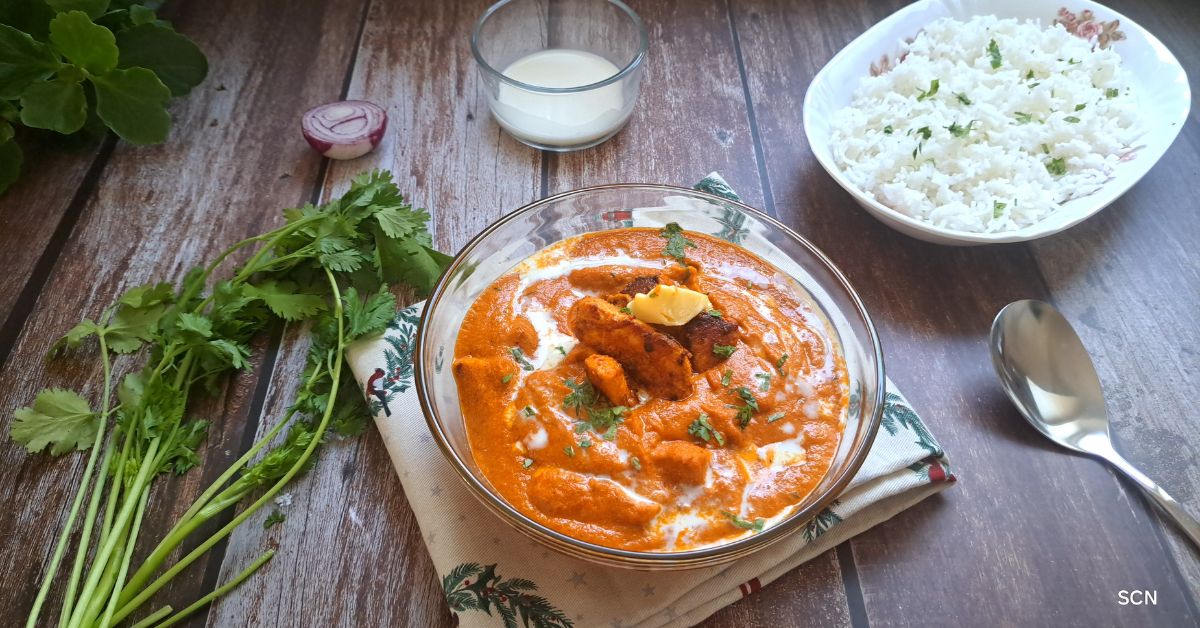
Butter Chicken, or “Murgh Makhani,” is a popular Indian dish loved for its rich, creamy flavour and tender chicken. Originating from Delhi, it features chicken cooked in a smooth tomato sauce made with butter, cream, and a blend of aromatic spices. Key ingredients include boneless chicken, tomatoes, yoghurt, garlic, ginger, and a mix of spices like garam masala and chilli powder. This comforting dish pairs wonderfully with naan bread or basmati rice, making it a perfect choice for a satisfying meal.
Butter Chicken, or “Murgh Makhani,” has a warm and inviting story that starts in Delhi, India. Created in the 1950s by a clever chef looking to make use of leftover tandoori chicken, it quickly became a beloved favourite. The dish blends tender chicken with a creamy, spiced tomato sauce made with butter and cream, giving it a rich, comforting flavour. Its popularity has spread worldwide, bringing a taste of Indian tradition to dinner tables everywhere.
Dhungar
Dhungar is a traditional Indian culinary technique used to impart a smoky flavour to a variety of dishes, including curries, meats, and dals. This method is particularly popular in Mughlai and North Indian cuisine, where the smoky aroma enhances the depth and richness of the dish.
How Dhungar Works?
After the butter chicken is cooked, a small piece of charcoal is heated until it becomes red-hot. The charcoal is then placed in a small bowl or foil cup, which is positioned in the center of the dish. A small amount of ghee (clarified butter) or oil is poured over the hot charcoal, causing it to emit smoke. The dish is immediately covered with a lid to trap the smoke, allowing it to permeate the chicken and sauce for several minutes. This process imparts a subtle yet distinct smoky flavour that enhances the rich, creamy tomato-based sauce.
The smoky flavour adds a layer of complexity to the butter chicken, balancing the richness of the butter and cream, the tanginess of the tomatoes, and the warmth of the spices. It introduces a tandoor-like flavour to home-cooked meals.
Liquid smoke
In modern variations, some chefs use smoked paprika or liquid smoke to achieve a similar effect, especially when cooking in kitchens where the traditional dhungar method isn’t practical. However, the charcoal smoking method remains the gold standard for those seeking to recreate the authentic taste of butter chicken.
Using liquid smoke in butter chicken is a convenient way to introduce that sought-after smoky flavour, especially if you don’t have the means to use the traditional dhungar method. Add a few drops (start with 1/4 teaspoon) of liquid smoke to the sauce while it’s simmering. This allows the flavour to meld with the other ingredients.
Alternatively, add liquid smoke after fully cooking the dish and stir it in gently. This method allows you to better control the intensity of the smokiness. Be cautious with the amount. Liquid smoke is potent, so start with just a few drops, taste, and adjust as necessary. It’s easier to add more than to correct an overly smoky flavour.
Grilling or Charring
For meats like chicken, you can grill or char the ingredients over an open flame before adding them to your dish. This imparts a natural smoky flavour similar to what you’d get from a tandoor. This provides an authentic smoky flavour with a crisp texture.
Using a Grill Pan for Smoky Flavour
Heat a grill pan over medium-high heat until it’s very hot. A well-heated pan is essential for getting those nice char marks and a smoky flavour. Lightly oil the grill pan to prevent the chicken from sticking. You can brush the chicken with a little oil as well for an extra char. Place the marinated chicken pieces on the grill pan. Cook the chicken on one side until you see nice grill marks, usually around 4-5 minutes.
Flip the chicken and ensure you char and cook the other side through. The slight charring adds a wonderful smoky flavour, similar to what you’d achieve with a tandoor or traditional grilling.
If you enjoyed my butter chicken recipe, be sure to try my other delicious chicken dishes like pepper chicken, grilled chicken, Malai chicken and more!
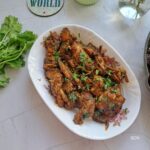
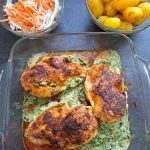
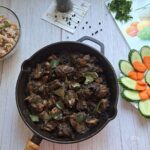
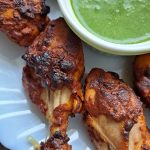
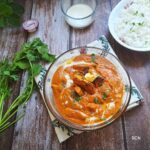
Butter chicken
Ingredients
For the chicken marinade
- 300 gms boneless chicken cut into bite-sized pieces
- 2 tbsp plain yoghurt
- 1 tsp ginger-garlic paste
- 2 tsp Kashmiri chilli powder
- ¼ tsp garam masala
- ¼ tsp turmeric powder
- ½ tsp dried kasoori methi leaves
- Salt to taste
- 1 tbsp lemon juice
For the butter chicken sauce
- 2 tbsp butter
- 1 large onion finely sliced
- 2 tomatoes finely chopped
- water as needed
- 2 tsp Kashmiri chilli powder adjust to taste
- ¼ tsp garam masala
- ⅛ tsp turmeric powder
- 1 tsp sugar optional, to balance acidity
- ½ tsp dried kasuri methi leaves
- Salt to taste
- 15-20 cashews
- Hot water (for soaking the cashews)
- 2 tbsp cream optional
- Fresh coriander leaves chopped (for garnish)
Instructions
- In a large bowl, combine the yoghurt, ginger-garlic paste, turmeric powder, Kashmiri chilli powder, garam masala, dried kasuri methi leaves, salt, and lemon juice.
- Add the chicken pieces and mix well to coat.
- Cover and refrigerate for at least 1 hour (or overnight for best results).
- Soak the cashews in hot water and set them aside.
- Preheat a grill, or you can use a stovetop pan. If using a stovetop grill pan, heat the pan and add a tablespoon of butter.
- Cook the marinated chicken until it’s well browned on all sides and cooked through. Set aside.
- In a large pan, heat the butter over medium heat.
- Add the chopped onions and sauté until golden brown.
- Add the chopped tomato and cook until the tomatoes are cooked well.
- Lower the heat and stir in the Kashmiri chilli powder, garam masala, and turmeric powder, and cook until the raw smell of the masala disappears.
- Cool and grind them to a fine paste. Add water if needed.
- Grind the soaked cashews to a fine paste along with the water and set them aside.
- In the same pan, heat the butter over medium heat.
- Add the ground onion-tomato paste, and cashew paste. Adjust the consistency by adding hot water as needed.
- Adjust the salt and the spice. Cook the mixture until the oil starts to separate and the sauce thickens (about 10 minutes).
- Stir in the sugar and dried kasuri methi leaves.
- Let the sauce simmer on low heat for 5-7 minutes, allowing the flavours to meld.
- Add the grilled chicken pieces to the sauce and stir well to coat.
- Simmer for another 5 minutes, letting the chicken absorb the flavours of the sauce.
- Garnish with fresh coriander leaves and fresh cream.
- Serve hot with naan, roti, or steamed basmati rice.
- Enjoy your delicious homemade butter chicken!
Notes
Frequently Asked Questions
Boneless, skinless chicken breasts or thighs work best. Thighs are more forgiving and tender, while breasts are leaner but can dry out if overcooked.
Yes, you can use boneless lamb, beef, or even tofu for a vegetarian option. Adjust cooking times accordingly, especially for different meats.
Adjust the amount of chilli powder and garam masala to suit your taste. For a milder version, reduce the chilli powder and avoid adding extra heat.
Yes, butter chicken often tastes better the next day as the flavours deepen. Store it in an airtight container in the refrigerator for 3-4 days or freeze it for up to 1 month.
You can serve them with naan, roti, or basmati rice. It also pairs well with steamed vegetables or a simple salad.
If the sauce is too thick, add a bit of hot water to reach the desired consistency. If it’s too thin, simmer it longer to reduce and thicken.
The rich colour of butter chicken comes from Kashmiri chilli powder. This type of chilli powder is known for its vibrant red colour and mild heat, making it ideal for adding colour without making the dish too spicy.
Regular chilli powder tends to be hotter and darker than Kashmiri chilli powder, and it won’t provide the same vibrant red colour. For the best results, stick to Kashmiri chilli powder.

1 thought on “Butter chicken”